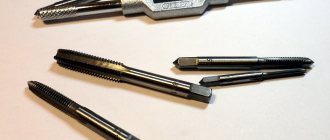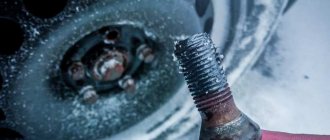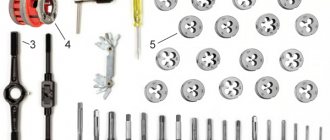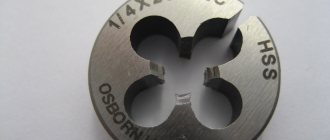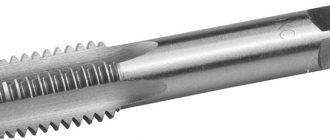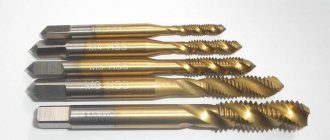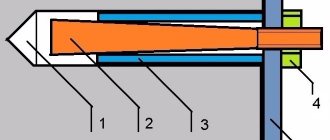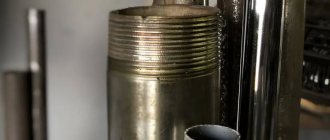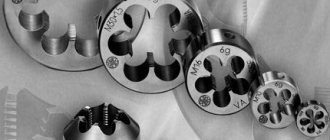Rules for cutting threads with a tap:
1) when cutting threads in deep holes, in soft and tough metals (copper, aluminum, babbitts, etc.), the tap must be periodically unscrewed from the hole and the tap grooves must be cleared of chips;
2) thread cutting should be carried out with a full set of taps. Cutting a thread immediately with a medium tap without going through a rough tap and then a finishing one does not speed up, but, on the contrary, complicates the work, leads to poor-quality threads, and sometimes to breakage of the tap. The second and third taps are inserted into the hole without a driver and only after the tap passes correctly along the thread, the driver is applied and threading continues;
3) blind holes for threads must be made to a depth slightly greater than the length of the part being cut, so that the working part of the tap extends slightly beyond the part being cut. If there is no such reserve, the thread will be incomplete;
4) during the cutting process, it is necessary to carefully ensure that there is no misalignment of the tap; To do this, every 2-3 threads you need to check the position of the tap in relation to the upper cut plane of the product using a square. Particular care must be taken when cutting threads in small and blind holes;
5) Cooling and lubrication are used to reduce heat on the tap and produce smoother, cleaner threads. A tap without lubrication heats up quickly and can jam and strip the thread. Emulsions, drying oil or oil (boiled, linseed) are used as lubricating and cooling liquids when cutting threads in steel products; kerosene is used in aluminum products; turpentine is used in copper products;
6) thread cutting in bronze and cast iron parts can be done dry.
It has been noticed that on many Golfs the rear engine mount (or gearbox) mount is a problem area, namely the internal thread in the aluminum gearbox housing.
So I haven’t had a thread for a long time, I noticed even from the purchase that it wasn’t screwed
, but the pin at 12 is clogged)) Recently it made itself felt, unpleasant sounds appeared when starting and braking, and when I reached out to replace the pillow, the bolts simply wouldn’t screw back in.
Types of instruments
The appropriate tool is selected depending on the characteristics of the material being processed, the required productivity and other parameters. Using different types of taps, you can cut metric or inch internal threads with a cylindrical or conical profile.
According to the method of conducting the process, models are distinguished:
- Pass-through (universal) . Their working part consists of three zones. The first performs rough cutting, the second – intermediate, and the third – finishing.
- Complete . To perform a full range of work, several tools are used - for roughing, intermediate and finishing cutting. The sets consist of three taps, less often of two (for roughing and finishing). For processing particularly strong metals, kits with 5 tools are used.
The tool is made of two types: for processing holes manually or using metal-cutting equipment.
- Machine-manual . Has a square shank. Works complete with a holder with two handles - a knob.
- Machine . Installed in the chuck of metalworking machines of various types.
Types and areas of application of taps
Internal thread cutting can be done manually or using various types of machines (drilling, lathe, etc.). The working tools that perform the main work of cutting internal threads are machine-hand or machine taps.
Taps are divided into different types depending on a number of parameters. The following principles for classifying taps are generally accepted.
- According to the method of rotation, a distinction is made between machine-manual and machine taps, with the help of which internal threads are cut. Machine-hand taps equipped with a square shank are used in conjunction with a special device with two handles (this is the so-called tap holder). With the help of such a device, the tap is rotated and cuts the thread. Thread cutting with a machine tap is carried out on metal-cutting machines of various types, in the chuck of which such a tool is fixed.
- Based on the method by which internal threads are cut, a distinction is made between universal (through) taps and complete taps. The working part of the former is divided into several sections, each of which differs from the others in its geometric parameters. The section of the working part that first begins to interact with the surface being processed performs rough processing, the second - intermediate, and the third, located closer to the shank - finishing. Cutting threads with complete taps requires the use of several tools. So, if a set consists of three taps, then the first of them is intended for roughing, the second for intermediate, and the third for finishing. As a rule, a set of taps for cutting threads of a certain diameter includes three tools, but in some cases, when products made of particularly hard material are processed, sets consisting of five tools can be used.
- Based on the type of hole on the inner surface of which it is necessary to cut a thread, taps for through and blind holes are distinguished. A tool for processing through holes is characterized by an elongated conical tip (approach), which smoothly passes into the working part. Universal type taps most often have this design. The process of cutting internal threads in blind holes is carried out using taps, the conical tip of which is cut off and performs the function of a simple milling cutter. This design of the tap allows it to cut threads to the full depth of a blind hole. To cut a thread of this type, as a rule, a set of taps is used, driven manually using a wrench.
- According to the design of the working part, taps can have straight, helical or shortened chip removal grooves. It should be borne in mind that taps with grooves of various types can be used for cutting threads in products made of relatively soft materials - carbon, low-alloy steel alloys, etc. If threads need to be cut in parts made of very hard or viscous materials (stainless, heat-resistant steels, etc.), then for these purposes taps are used, the cutting elements of which are arranged in a checkerboard pattern.
A good tap is made of high-quality tool steel, looks neat and has smoothly machined turns and grooves
Taps are usually used for cutting metric threads, but there are tools that can be used to cut pipe and inch internal threads. In addition, taps also differ in the shape of their working surface, which can be cylindrical or conical.
How to correctly determine the hole diameter?
Before cutting a thread, a hole is made, the diameter of which is determined according to standardized tables. If you prepare a hole whose cross-section is smaller than the recommended size, the tool will fail; if it is larger, the result will be of poor quality.
Correspondence table for metric threads and hole diameters for them
| Thread designation | Diameter, mm | Thread designation | Diameter, mm | Thread designation | Diameter, mm |
| M 2 | 1,6 | M 8 | 6,7 | M 22 | 19,4 |
| M 2.2 | 1,75 | M 9 | 7,7 | M 24 | 20,9 |
| M 2.5 | 2,05 | M 10 | 8,5 | M 27 | 23,9 |
| M 3 | 2,5 | M 11 | 9,5 | M 30 | 26,4 |
| M 3.5 | 2,9 | M 12 | 10,2 | M 33 | 29,4 |
| M 4 | 3,3 | M 14 | 12,0 | 31,9 | |
| M 5 | 4,2 | M 16 | 14,0 | M 39 | |
| M 6 | 5,0 | M 18 | 15,4 | M 42 | 37,4 |
| M 7 | 6,0 | M 20 | 17,4 | M 45 | 40,4 |
Correspondence table for inch threads and hole diameters for them
| Thread size, inches | Diameter, mm | Thread size, inches | Diameter, mm |
| 1/8 | 8,8 | 7/8 | 28,1 |
| 1/4 | 11,7 | 1 | 30,5 |
| 3/8 | 15,2 | 1 1/8 | 35,2 |
| 1/2 | 18,9 | 1 1/4 | 39,2 |
| 5/8 | 20,7 | 1 3/8 | 41,6 |
| 3/4 | 24,3 | 45,2 |
Features of the technology
When cutting internal threads with a tap, the following algorithm is used.
- In the place on the surface of the workpiece where the hole for threading will be drilled, it is necessary to form a recess for a more accurate entry of the drill, using a core and a regular hammer. The drill is fixed in the chuck of an electric drill or drilling machine, on which low rotation speeds of the tool are set. Before starting drilling, the cutting part of the drill must be treated with a lubricating compound: a lubricated tool enters more easily into the structure of the material being processed and creates less friction in the processing area. You can lubricate the drill with a piece of ordinary lard or grease, and when processing viscous materials, machine oil is used for these purposes.
- If it is necessary to cut threads in small parts, they should first be fixed using a bench vice. When starting drilling, the tool fixed in the equipment chuck must be positioned strictly perpendicular to the surface of the workpiece. You should lubricate the tap regularly and ensure that it does not warp and moves strictly in the given direction.
- At the entrance to the hole, as mentioned above, it is necessary to remove the chamfer, the depth of which should be 0.5–1 mm (depending on the diameter of the hole). For this purpose, you can use a larger diameter drill or countersink, installing them in the chuck of drilling equipment.
- The process of cutting internal threads begins with tap No. 1, which is the first to be installed in the driver. We should not forget about the lubricant, which must be applied to the tap for threading. The position of the tap relative to the hole being machined must be set at the very beginning of the work, since later, when the tool is already inside the hole, this will not be possible. When cutting a thread with a tap, you must adhere to the following rule: 2 turns of the tap are made in the direction of cutting the thread, 1 - against the direction. When the tap makes one revolution back, chips are thrown off its cutting part and the load on it is reduced. Thread cutting with a die is performed using a similar technique.
- After cutting the thread with tap No. 1, tool No. 2 is installed in the driver, and after it – No. 3. They are processed according to the method described above. When cutting threads with taps and dies, you need to feel when the tool begins to rotate with force. As soon as such a moment occurs, you should turn the knob in the opposite direction to throw the chips off the cutting part of the tool.
The harder the material being processed, the more abundantly the tap must be lubricated during the thread cutting process.
Before making internal threads with a tap or cutting threads with a die on external surfaces, you should thoroughly study these procedures and strictly follow the rules for their implementation. Only in this case can you count on the result satisfying you with its quality and accuracy.
Stages of thread cutting with a machine-hand tap
Work order:
- The first step is marking in accordance with the drawings.
- According to the marks, punching is carried out with a sharply sharpened core.
- Drill with medium pressure at low speeds. The drill should be at right angles to the surface. Before starting work, the drill is lubricated. If the hole depth is large, then lubrication is carried out not only before starting, but also during operation. The depth of the blind hole should be slightly greater than the length being cut. If there is no reserve, the thread may be incomplete.
- The quality of the result can be improved by countersink processing, which reduces the taper and ensures parallelism of the side surfaces.
- The tap is secured in the driver, its tip is lubricated and inserted into the hole strictly at right angles to the surface. Make the first turn, lightly pressing the knob from above. After the first turn forward, make a half turn back to remove chips. Particular care is taken when using a multi-tool - it is fragile and easy to damage. It's easier to work with complete models.
Gutter cutting machine
A machine for cutting threads on pipes is unlikely to be needed by a person who is equipping his home. It's more of a working tool. In design, it is somewhat reminiscent of vertical drilling machines.
The diameter of the workpiece and the cutting pitch are adjustable. The operation of the spindle can be carefully debugged by adjusting the number and speed of revolutions. In principle, such a machine does almost all the work. Also, unlike manual lechers, the machine can make not only external threads, but also internal ones. More modern machines can process the smallest parts and products with thin walls.
In the following video you can clearly see how the machine works without distortions:
Useful tips
- In order to correctly cut threads in metals with low hardness and high viscosity, such as aluminum, alloys based on it, copper, babbitt, it is recommended to periodically remove the tap to clean the channels from adhering chips.
- When using complete models, the complete set should be used. Skipping the roughing tool does not speed up, but slows down cutting. Such a violation of technology leads to a decrease in the quality of the result, and sometimes to failure of the tap.
- To prevent the tap from skewing, check the verticality of its position after 2-3 threads using a square. This precaution is especially important for blind and small holes.
The process must be carried out using liquids intended for lubrication and cooling:
- emulsions, linseed oil, and drying oil are used in steel elements;
- in products made of aluminum and its alloys - kerosene;
- when processing copper - turpentine.
It is possible to cut threads in parts made of cast iron or bronze without the use of lubricant.
What should you know about carving?
When installing shut-off valves, adapter tees or couplings on a metal pipe, a thread must be made, which is characterized by the following parameters:
- Depth
- the distance from the base of the thread to the end of the pipe. - The profile and its angle
- the cross section of the coil, which is made in the form of a triangle, rectangle and other shapes. When the side edges of the coils intersect, an angle is formed. - Pitch
- the distance that is formed between the tops of the pipe or nearby turns.
The determination of the profile and pitch should be treated with maximum attention, since the type of thread depends on this:
- Inch
- appears as a triangle and is used when assembling elements of a water pipe, and sometimes a heating pipe. - Cylindrical
is a version of an inch thread that has a smaller pitch. The smoothed top edge of the profile resembles a cylinder. An example of an external cylindrical thread diagram is presented below: - Conical
- the type allows you to obtain a hermetically sealed connection, which is especially important when using sealing materials. - Metric
- this type is used for small diameter pipes. It can be trapezoidal - the outer angle is 30 degrees, and the sides of the coil resemble a trapezoid. For bolted connections, rectangular threads can also be used, since they make the fixation more reliable. Here is a diagram of a metric thread, which looks like an equilateral triangle:
Threaded hole repair (restoring damaged threads)
Our company does not restore threads. This article is intended solely to introduce you to the thread restoration process. In our stores you can buy fittings (threaded inserts), drills, taps, thread restoration kits.
The information is intended for persons carrying out repairs in a personal garage and car repair shops. In accordance with this, the text is structured and recommendations are given. The use of this method in manufacturing enterprises involves the use of specific tools and devices, and other technology.

